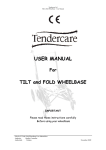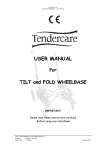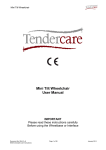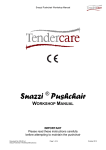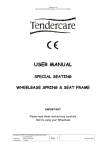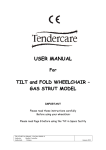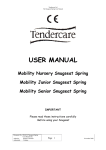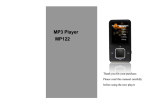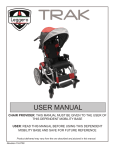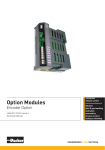Download Original Mini Tilt User Manual
Transcript
+ USER MANUAL For MI NI TILT WHEELCHAIR IMPORTANT Please read these instructions carefully Before using your wheelchair Mini Tilt Wheelchair User Manual v2 Authority. Quality Controller Authorised. J Adams November 05 Headrest Armrest Push Handle Footrest Backrest Lock Brake Lever Gas Strut Operating Lever Tipping Lever TENDERCARE MINI TILT WHEELCHAIR Mini Tilt Wheelchair User Manual v2 Authority. Quality Controller Authorised by, J Adams Page 2 of 15 November 05 Tendercare Ltd Mini Tilt Wheelchair User Manual CONTENTS ITEM DESCRIPTION PAGE 1 Who to contact if you have difficulty………………………………. 4 2 Intended user………………………………………………………… 4 3 Unpacking……………………………………………………………. 4 4 Preparing for use…………………………………………………….. 5 4.1 4.2 4.3 4.4 4.5 4.6 4.7 Unfolding and assembling the wheelchair……………………….. Adjusting the footrests…………………………………………… Fitting and removing headrest……………………………………. Tilt in Space……………………………………………………… Tyres and Brakes…………………………………………………. Rear Wheel Position……………………………………………… Tipping the Wheelchair………….………………………………. 5 6 7 8 8 9 10 User instructions…………………………………………………….. 10 5.1 Getting into the wheelchair………………………………………. 5.2 Getting out of the wheelchair…………………………………….. 5.3 Sideways transfer………………………………………………… 10 10 10 Attendant Pushing…………………………………………………… 11 6.1 6.2 6.3 6.4 Pushing…………………………………………………………… Brakes…………………………………………………………….. Comfort…………………………………………………………... Lifting and general safety………………………………………... 11 11 12 12 7 Cleaning……………………………………………………………… 12 8 Maintenance…………………………………………………………. 12 8.1 Routine maintenance…………………………………………….. 8.2 Six monthly maintenance………………………………………… 12 13 9 Warranty……………………………………………………………... 13 10 Transporting the wheelchair………………………………………... 13 11 Repairs……………………………………………………………….. 15 5 6 Mini Tilt Wheelchair User Manual v2 Authority. Quality Controller Authorised by, J Adams Page 3 of 15 November 05 Tendercare Ltd Mini Tilt Wheelchair User Manual 1. Who to contact in difficulty Tendercare Ltd PO Box 3091, Littlehampton, BN16 2WF Tel (01903) 726161 Fax (01903) 734083 Email: [email protected] 2. Intended user This product benefits from a tilt in space facility and has been designed for use as a wheelchair or wheelbase for use with special seating systems. It is available in three seat widths 305mm (12”), 356mm (14”) and 406mm (16”). These instructions apply to all sizes. The wheelchair has four wheels the front wheels are castors to allow easy steering. The backrest can be folded for transit. The armrests lift off for easy side transfer and the push handles are adjustable in height to suit a wide range of attendants. The maximum carrying weight including the user and all accessories should not exceed 102kg (16 stone). 3. Unpacking The wheelchair is delivered in a cardboard carton approximate weight 23 kg and size 700 mm wide x 570 mm deep x 950 mm high. Warning the transit carton is heavy so moving and unpacking must be done with care. Observe all lifting and handling regulations. 1) Stand the Carton upright making sure it is supported and cannot fall over. Open the carton and remove any packages or packing, which could obstruct the removal of the frame. Carefully pull out the wheelchair and check that you have the following items:- 2) Item 1. 2. 3. 4. 5. 6. Component Mini Tilt wheelchair Armrests Push handles Thumb screws (for push handles) Footrests User Manual Number Yes No 1 2 2 4 2 1 If any items are damaged or missing please contact Tendercare, Preferably by fax 01903-734083 within 36 hours of delivery. 3) After unpacking and checking you have all components and that they are in good condition, carefully dispose of the packaging at your local recycling centre. Mini Tilt Wheelchair User Manual v2 Authority. Quality Controller Authorised by, J Adams Page 4 of 15 November 05 Tendercare Ltd Mini Tilt Wheelchair User Manual 4. Preparing for use and operation Warning: - when assembling the wheelchair for use, ensure that you hold the frame so that you avoid any danger of catching your fingers in moving parts. 4.1 Assembling the wheelchair 1) Carefully lift the wheelchair upright. 2) Backrest supports. Standing behind the wheelchair lift the two-backrest locking pins using the ball shaped handgrips at the bottom of the backrest tubes. Turn them so that they lock into the groove arrowed opposite. Lift backrest supports vertical. Lock the supports in position by moving the handgrips out of the arrowed groove (see photo) and make sure they move to the bottom of the slot in the backrest tube. 3) Push handles. The height of the push handles can be adjusted to suit the needs of a large range of attendants. To adjust the height to suit you, simply loosen (turn anti clockwise) the two thumbscrews at either side and near the top of the backrest. (See photo opposite). Lift or lower the push handles to a height that suits you then retighten (turn clockwise) the thumbscrews. Tip: - To prevent the push handles moving in use these screws must be tight. You should regularly check that they are tightened properly. Mini Tilt Wheelchair User Manual v2 Authority. Quality Controller Authorised by, J Adams Page 5 of 15 November 05 Tendercare Ltd Mini Tilt Wheelchair User Manual 4) Armrests. To fit the armrest loosen thumbscrew “A” (turn anti clockwise) and turn catch “B” a quarter turn then push the armrest into the socket. Make sure that the longer part of the tube supporting the armpad points to the backrest. To lock the armrest turn catch “B” upright and tighten the thumbscrew “A”. (See photo opposite To adjust the height of the armrest loosen the thumbscrew, turn the catch and move the armrest to the desired height. Turn the catch making sure it is one of the holes in the armrest vertical tube and retighten the thumbscrew. CATCH “B” THUMBSCREW “A” To fold the wheelchair, do the reverse of the above. 4.2 Adjusting footrests The footrests are fitted to the wheelchair when it is supplied. They can be moved forward and back, up and down. The footplate can be lifted to the vertical when getting into and out of the wheelchair. 1. Moving the footrests forward and backwards. The footrest can be fitted in one of two positions. To move the footrest, remove the nut, washer and bolt located under the front of the seat support tube using 10mm spanners. (See Picture opposite). Move the footrest to the alternative position. Reinsert the bolt from the outside of the wheelchair fit the washer and nut and tighten. Mini Tilt Wheelchair User Manual v2 Authority. Quality Controller Authorised by, J Adams Page 6 of 15 November 05 Tendercare Ltd Mini Tilt Wheelchair User Manual 2. Adjusting the footrest height INDENTATION Using a 5mm hexagon key loosen the screw on the side of the footrest. (See photo opposite.) Move the footrest to the desired height and retighten the screw. SCREW IMPORTANT: -Make sure the screw fits into an indentation in the footrest support rod. 3. Lifting footplate The footplates can be lifted into vertical position to make it easier to get in and out of the wheelchair. To do this, simply hold the front of the footplate and lift up. 4.3 Fitting and Removing Headrest (Optional Extra) If the headrest is purchased as an optional extra it should be fitted as follows: Place the headrest support tubes into the top of the backrest tubes just in front of the push handles (see photo opposite). A Fit the headrest upholstery (A) over the two support rods. Attach the headrest cushion (B) using the Velcro strips. B Reverse the above to remove the headrest Mini Tilt Wheelchair User Manual v2 Authority. Quality Controller Authorised by, J Adams Page 7 of 15 November 05 Tendercare Ltd Mini Tilt Wheelchair User Manual 4.4 Tilt in Space The angle of the seat and backrest can be adjusted to any angle between the upright and fully reclined position. To recline the seat, put the brakes on and stand behind the wheelchair. Holding both push handles squeeze the operating lever (see photo opposite) and push down evenly on both handles. Release the lever when the seat is at the desired angle. To bring the seat upright put the brakes on and stand behind the wheelchair. Holding both push handles squeeze the operating lever (see photo opposite) and lift evenly on both handles. Release the lever when the seat is at the desired angle. OPERATING LEVER Important: - Always put the brakes on and move both push handles together when adjusting the seat angle. 4.5 Tyres and Brakes The tyres are made from a solid material and do not require any attention other than being cleaned with a damp cloth when dirty. Check brakes by moving both levers forward as far as they will go. The wheels should now be locked. If the wheels move the brakes need adjusting. Adjust the brakes by loosening the nut (arrowed) locking the brake pad in place. Turn the brake pad so that it is near to, but not touching, the tyre. Retighten the locking nut. Always adjust both brakes at the same time and recheck that the brakes work properly. Note: Don’t leave the brakes ON for a long period. If you do a flat section may appear on the tyre. When not using the wheelchair i.e. overnight or during storage make sure the brakes are OFF. Mini Tilt Wheelchair User Manual v2 Authority. Quality Controller Authorised by, J Adams Page 8 of 15 November 05 Tendercare Ltd Mini Tilt Wheelchair User Manual 4.6 Rear Wheel Position The rear wheel is supplied mounted in its forward position to provide optimum ease of manoeuvring and tipping. However, a small number of people may require a greater degree of stability. If this is the case the rear wheel and brake can be moved to its rear mounting. It is recommended that a technician or competent person only does this. TIPPING LEVER Using two 19mm spanners undo the axle-mounting nut. Make sure you note the position of the washer. Move the wheel to the rear hole refit the washer, apply Loctite to the threads refit the nut and tighten. (See picture opposite). To move the brake assembly use a 3 mm hexagon key and 8 mm spanner to remove the rear brake linkage screw making a note of the position of the spacers. (See photographs opposite and below). LOOKING FROM REAR OF WHEELCHAIR Using a 4 mm hexagon key remove the two back-plate retaining screws and move the plate back so that its fixing screws fit the into the two rear holes on the wheelchair frame. Refit the screws making sure that the washer and spacer is correctly positioned. (See Photographs below). REAR MOUNTING HOLES FRONT MOUNTING HOLES SPACER BRAKE BACK PLATE FIXING SCREW Finally adjust the brakes as described in section 4.5 above. Mini Tilt Wheelchair User Manual v2 Authority. Quality Controller Authorised by, J Adams Page 9 of 15 November 05 Tendercare Ltd Mini Tilt Wheelchair User Manual 4.7 Tipping the Wheelchair TIPPING LEVER To tip the wheelchair backwards when climbing kerbs stand behind the wheelchair holding onto both push handles. Place one foot, either the right or left whichever suits you, onto the tipping lever as shown in the picture opposite. Press down with your foot and pull back with your arms. The front of the chair will lift. IMPORTANT: - Take great care when doing this to avoid the combined weight of the wheelchair and occupant overcoming your strength and tipping back onto you. Never try to tip the wheelchair if the occupant is much heavier than you are. 5. User Instructions 5.1 Getting into the wheelchair 1) 2) 3) 4) Put the brakes on. Lift the footplates. Lower yourself onto the seat using the armrests for support. Lower footrest into place and rest your feet on them. 5.2 Getting out of the wheelchair 1) 2) 3) 4) Put the brakes on. Lift footrests. Place arms on armrests. Slowly push yourself up to a standing position. 5.3 Sideways Transfer 1) 2) 3) 4) 5) Put the brakes on. Lift footplates and put feet on the ground. Lift off armrest on the side you are transferring from. Place transfer board from the wheelchair seat to the easy chair, bed etc. Slide across the board whilst leaning slightly forwards and taking care not to move the wheelchair or transfer board Mini Tilt Wheelchair User Manual v2 Authority. Quality Controller Authorised by, J Adams Page 10 of 15 November 05 Tendercare Ltd Mini Tilt Wheelchair User Manual 6. Attendant Pushing 6.1 Pushing 1) The wheelchair is easy to push over hard, even surfaces but may be more difficult over rough; uneven surfaces and the wheels may sink into soft ground. Never force the wheelchair if it becomes stuck, this may cause the rear wheels to lift and the user may be tipped out of the chair. If the wheelchair gets jammed on a stone or cracked pavement, tip the wheelchair backwards using the tipping levers to raise the castors over the obstacle and then proceed. On soft ground it may be easier to pull the wheelchair backwards. 2) Whenever possible avoid steep and uneven surfaces because there is a danger that the wheelchair may tip over. If you cannot avoid difficult surfaces you must take extra care when travelling across them. 3) Do not use the wheelchair in sandy conditions. 4) Always use two hands for pushing the wheelchair. 5) The wheelchair is steered by the front castors. Most pavements slope slightly towards the kerb and the chair will have a tendency to curve in the downward direction towards the road. Two hands will be needed to prevent this. 6) For the comfort of the occupant always avoid pushing too fast or making sudden fast turns, jerking, jolting or bumping. Many occupants are liable to be affected by rough handling, which can cause loss of confidence, discomfort or pain. 7) Avoid kerbs. Wherever possible use ramped kerbs or slopes. This will make pushing the chair easier and safer and will be more comfortable for the occupant. 8) Avoid steep kerbs and flights of steps because of the danger of losing your grip on the chair or of the occupant being tipped out. Always use a ramp or lift if available. 9) Always look well ahead so that you have plenty of time to avoid hazards. 10) Be considerate to other people and watch out for pedestrians who may stop or suddenly change direction. 6.2 Brakes 1) Always put the brakes on when getting into or out of the wheelchair and when leaving the occupied wheelchair unattended. 2) To avoid making flat sections on the tyres never store the wheelchair with the brakes on for long periods i.e. overnight or during storage. Mini Tilt Wheelchair User Manual v2 Authority. Quality Controller Authorised by, J Adams Page 11 of 15 November 05 Tendercare Ltd Mini Tilt Wheelchair User Manual 6.3 Comfort 1) Always be considerate to the occupant 2) Before setting out on a journey make sure the occupant is comfortably and correctly seated and that any safety straps of harnesses are correctly adjusted and used. Always ensure that both feet are on the footrests and that clothing is tucked in and cannot catch on the wheels. 3) Remember the occupant is in front of you. They will want to be part of your conversations and interests. Also their view will be different to yours when it comes to looking into shop windows, etc. it can be extremely frustrating to hear an exciting bargain being discussed when it is situated somewhere behind the wheelchair occupant’s ear, and thus, out of sight. 6.4 Lifting and general safety 1) The wheelchair is designed to be used by one person only. Never allow children to play on the wheelchair or stand on the footrests or tipping levers. Never hang anything such as bags on the push handles. If you do, there is a danger of the wheelchair tipping backwards. 2) Never try to lift the wheelchair when the user is sitting in it. 3) For your own safety and good practice never lift the empty wheelchair until it has been properly folded. Always use good lifting practice. 7. Cleaning 1) Whenever the wheelchair gets dirty it should be cleaned using a damp cloth and then dried thoroughly. 2) For more stubborn stains wipe with a damp cloth using a mild solution of warm water and soap. 3) Never use furniture polish or spirit to clean the frame. 8. Maintenance 8.1 Routine maintenance The user or their family can easily carry out the following tasks. No tools are required. 1) Always wipe the wheelchair dry. Never put it away damp. 2) Check all four-push-handle retaining knobs are in place and are hand tight (daily). 3) Check brake operation (weekly). 4) Check operation of tilt mechanism (weekly). 5) Clean frame when necessary (we suggest at least once a week). Mini Tilt Wheelchair User Manual v2 Authority. Quality Controller Authorised by, J Adams Page 12 of 15 November 05 Tendercare Ltd Mini Tilt Wheelchair User Manual 8.2 Six monthly maintenance Someone who is a competent tradesman or repairer should only carry out this work. If a major fault is found stop using the wheelchair until it has been corrected. 1) Examine the frame for any damage. If frame is damaged DO NOT use the wheelchair until it has been repaired. 2) Examine upholstery for wear and arrange for replacement if necessary. 3) Examine nuts, bolts, pivots and frame plugs for tightness and general condition. 4) Examine push-handle retaining knobs and check they are hand tight. 5) Examine brake assemblies for wear, damage and adjustment. 6) Examine tilt mechanism and check operation of reclining mechanism. 7) Examine front castors for free rotation of castor assembly and wheel. Check rear wheels for free rotation. For all other repairs refer to your issuing authority or Tendercare Ltd. 9. Warranty 1) Tendercare undertakes to repair or replace free of charge, any parts or part found to be defective due to manufacturer within a period of 12 months from the date of delivery. 2) Tendercare Limited will not repair or replace free of charge any part or parts found to be defective due to abuse, misuse or lack of correct maintenance. 3) Equipment for warranty claims should be returned in a strong carton. There may be a charge for collection. Contact customer service department on 01903 726161. 10. Transporting The Mini Tilt wheelchair can be transported in the luggage boot of a motorcar. The Mini Tilt wheelchair has been successfully impact tested against International Standard ISO7171-19 and may be used as a vehicle seat. When used as a vehicle seat the following instructions must be followed. The front of the wheelchair must be facing towards the front of the vehicle. (In the direction of travel). The seat must be in the most upright or mid reclined position. Mini Tilt Wheelchair User Manual v2 Authority. Quality Controller Authorised by, J Adams Page 13 of 15 November 05 Tendercare Ltd Mini Tilt Wheelchair User Manual If a seat cushion is used this must be attached to the wheelchair backrest. (This is necessary to prevent the cushion from moving and allowing the occupant to “submarine” under the seat belt). The wheelchair must be attached to a vehicle using a 4-Point wheelchair restraint that complies with ISO 10542, SAE2249 or DIN7507/2. No other restraint system can be used. A trained person should only attach the restraints. The restraint anchorage points are marked on the wheelchair with silver labels as shown in the photograph below. Front Restraint Location Point The front restraint must be attached to front frame behind the cross tube with the webbing passing over the side tube. (See picture opposite). Rear Restraint Location Point The rear restraint must be fitted around the backrest tube just above the joint of the backrest with the upper side frame i.e. between the seat and backrest upholstery. (See picture opposite). Important: - In addition to securing the wheelchair the occupant must always be restrained by an approved vehicle belt providing lap and over the shoulder protection. Fitting Passenger Belts The passenger MUST be restrained using an approved vehicle safety belt. Tendercare Ltd recommends the use of either a split reel double inertia seat belt or 3-point occupant restraint system. (Such restraints are manufactured by Unwin Safety Systems & Q’Straint). Alternatively the user may be transferred to an approved vehicle seat and the wheelchair folded and placed safely in the luggage area of the vehicle. Mini Tilt Wheelchair User Manual v2 Authority. Quality Controller Authorised by, J Adams Page 14 of 15 November 05 Tendercare Ltd Mini Tilt Wheelchair User Manual A trained person should only attach the restraints. Important Points. In an emergency press the quick release buckles 1) The lap strap must be located as low down over the hips as possible. It must not cross the stomach of the passenger. 2) Adjust the shoulder strap/s so that it does not press against the passenger’s neck but passes over middle of the shoulder. Warnings: The Mini Tilt Wheelchair should only be secured in vehicles using a 4-point webbing restraint system that complies with ISO 10542 Part 2, SAE2249 or DIN 75078/2. NO other restraint system can be used. Any item involved in an accident no matter how minor MUST BE WITHDRAWN FROM SERVICE IMMEDIATELY AND REPLACED. 11. Repairs 1) Repairs; for all repairs contact your issuing authority. 2) Major repairs; for all major repairs e.g. bent or damaged frame, the equipment should be returned to the factory. Contact Tendercare Ltd customer services on 01903 726161. 3) An approved agent may carry out the following repairs and replacements. A workshop manual is available to repairers. Brake adjustment, replacement of front castors; rear wheels, armpads, seat and backrest upholstery, gas strut and interconnecting cables. Important Points 1) 2) 3) 4) Do not reuse Nyloc nuts. Always replace with a new Nyloc nut. Always use Loctite thread locking compound Grade 241. Always use recommended components and parts available from Tendercare Ltd. Do not modify or repair the frame Mini Tilt Wheelchair User Manual v2 Authority. Quality Controller Authorised by, J Adams Page 15 of 15 November 05
















